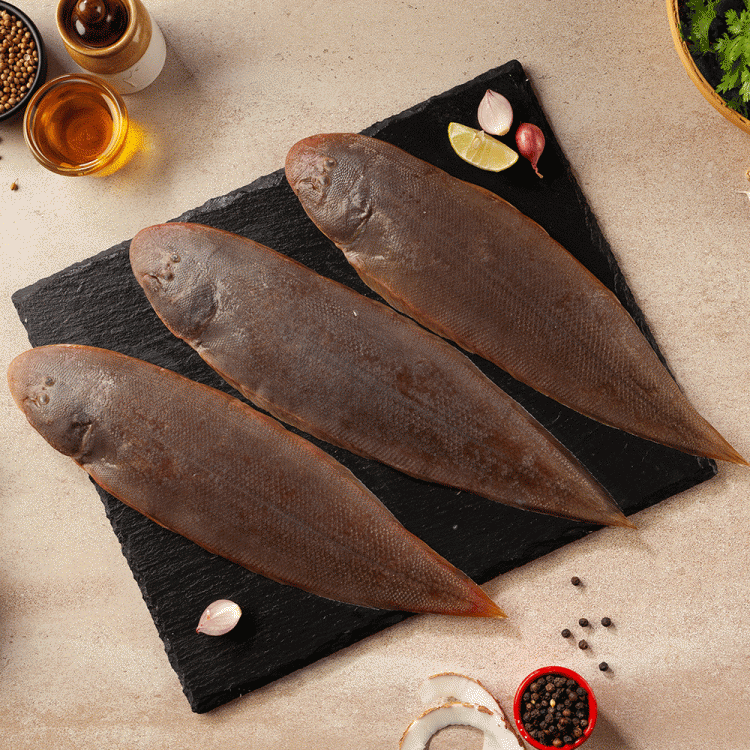Species Overview: Sole Fish

Sole fish, a type of flatfish, are characterized by their laterally compressed, oval-shaped bodies. They possess a unique adaptation, with both eyes migrating to one side of the head during their larval stage. This specialized feature allows them to rest on the seabed with one eye facing upward for surveillance while the other remains concealed beneath.
The sole fish, with its delicate flesh and subtle flavor, has a culinary charm that captivates. Yet, its close cousin, the skate fish , holds its own allure. With its firm texture and slightly sweet taste, the skate fish offers a unique culinary experience.
Returning to the sole fish, its versatility extends beyond the plate, as it graces art and literature with its elegant form.
Sole fish are generally bottom-dwellers, inhabiting sandy or muddy substrates in both shallow and deep waters. Their diet primarily consists of small invertebrates, such as worms, crustaceans, and mollusks, which they locate using their sensitive chemosensory organs.
Sole fish, with their delicate flesh and subtle flavor, have long been a delicacy in coastal communities. Their unique ability to swim close to the ocean floor reminds me of the graceful basketball floater , a shot that gently arcs over the outstretched arms of defenders.
Like the sole fish, the basketball floater seems to glide effortlessly through the air, finding its way to the basket with finesse.
The life cycle of sole fish involves a planktonic larval stage followed by a benthic adult stage. After hatching, the larvae drift with ocean currents before settling on the seabed and undergoing metamorphosis into juvenile fish. As they mature, sole fish develop their characteristic flat shape and cryptic coloration, allowing them to blend seamlessly with their surroundings.
Geographical Distribution
Sole fish are found in various regions across the globe, including the Atlantic, Pacific, and Indian Oceans. Different species have adapted to specific habitats, with some preferring shallow coastal waters while others inhabit deep-sea environments.
Culinary Importance
Sole fish has gained significant culinary prominence due to its delectable flavor and delicate texture. Its versatility in the kitchen makes it a favorite among seafood enthusiasts and culinary experts alike.
Sole’s mild flavor and firm yet tender flesh allow it to pair harmoniously with various culinary techniques, from pan-frying to baking and steaming. Its delicate nature also makes it an excellent choice for creating elegant and sophisticated dishes.
Recipes and Cooking Techniques
Sole fish can be prepared in a myriad of ways, each highlighting its unique flavor and texture. Some popular cooking methods include:
- Pan-frying: Sole fillets are dredged in flour and pan-fried until golden brown, resulting in a crispy exterior and a tender, flaky interior.
- Baking: Sole fillets are baked in the oven with herbs and butter, creating a moist and flavorful dish.
- Steaming: Sole fillets are steamed until cooked through, preserving their delicate flavor and nutrients.
Nutritional Value, Sole fish
Sole fish is not only delicious but also packed with essential nutrients. It is a rich source of:
- Protein: Sole provides a substantial amount of high-quality protein, which is crucial for muscle growth and repair.
- Omega-3 fatty acids: Sole contains high levels of omega-3 fatty acids, which are essential for heart health and cognitive function.
- Vitamins and minerals: Sole is a good source of vitamins B12, D, and selenium, as well as minerals like potassium and magnesium.
Consuming sole fish regularly can contribute to overall health and well-being.
Commercial and Recreational Fishing

Sole fish are commercially important, and several species are targeted by fishing fleets worldwide. Commercial fishing for sole typically involves large-scale operations using trawls, which are nets dragged along the seafloor. Trawling can be efficient but also has environmental concerns, such as bycatch and habitat disturbance. Other methods used to catch sole include longlines and gillnets.
Regulations governing the harvest of sole vary by region and species. These regulations aim to ensure sustainable fishing practices and protect sole populations. Measures may include quotas, size limits, closed seasons, and gear restrictions.
Recreational Fishing
Sole are also popular targets for recreational anglers. They can be caught from boats or from shore using a variety of methods, including baitcasting, jigging, and trolling. Sole fishing can be a rewarding experience, and these fish are often considered excellent table fare.
When fishing for sole, it’s important to use appropriate gear and techniques. Light to medium-weight tackle is typically sufficient, and bait can include live worms, small fish, or lures that mimic their prey. Patience and persistence are key, as sole can be elusive at times.
In the culinary world, the sole fish, a member of the flatfish family, is a highly sought-after delicacy. Its delicate flavor and flaky texture make it a favorite among seafood enthusiasts. Learn more about the captivating world of sole fish and discover its unique characteristics and culinary versatility.
The sole fish, with its flat body and delicate flavor, has a surprising connection to the world of basketball. In the realm of the hardwood, the term “pike” refers to a basketball move where a player drives towards the basket while simultaneously jumping and extending their arm to shoot.
Like the sole fish, the pike move requires precision and finesse to execute effectively, making it a formidable weapon in the arsenal of any skilled basketball player.
Like a regal ruler on the ocean floor, the sole fish glides effortlessly, its flat body resembling a majestic canvas. Its elegance extends beyond its physical form, as it often serves as a poster fish for the health of marine ecosystems.
The sole fish’s sensitive nature makes it an indicator species, its well-being a reflection of the ocean’s overall vitality.